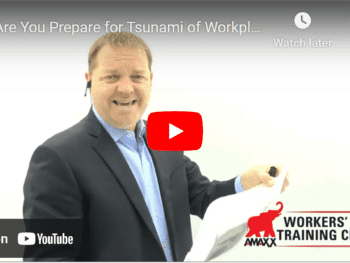Lowering Workers’ Comp Costs – Best Practices webinar attracted over 750 industry professionals, including employers, risk managers, safety directors, brokers, consultants, or producers involved in claims management, specific aspects of cost containment, and/or, the latest workers’ comp strategy issues. The webinar was jointly hosted by Advisen and Amaxx Risk Solutions.
A panel of experts speakers, California Pizza Kitchen’s David Williams, Blackstone Consulting’s Mark Newman, Arthur Gallagher’s Bob Walker, Amaxx Risk Solutions’ Rebecca Shafer and Michael Stack, and Advisen’s Dave Bradford, discussed how organizations, big and small, can hone their injury procedures in order to significantly reduce their workers’ comp expenses by applying proven workers’ comp best practices.
It was a fast moving event that generated a number of questions. Here are some of the questions and answers:
Q: What are some examples of red flags of fraud?
A: A couple are: claimant moves out of state, claimant is never home, claimant IS home but doesn’t answer phone, claimant’s recovery is longer than the duration guidelines indicate. This is just a few of many. Chapter 15 covers this in great detail and discusses ways to control fraud and abuse.
Q: How are ADA AA-related (American with Disabilities Act Amendment Act) concerns and activities managed from a Risk Management perspective? What are you advising clients about their legal obligations under the Act?
A: These can be tricky, and state laws can have more stringent requirements than the ADAAA which is federal. My initial response to this question was removed temporarily while we consult the EEOC regarding exactly when an employer’s duty to begin the interactive process to accomodate an injured employee with a transitional duty assignment attaches. Stay tuned. In the interim, the RM department needs to work with HR and Legal to ensure that they are compliant with ALL laws. Once the employee reaches MMI, and in some cases even before that while the employee is on transitional duty, there needs to be an interactive process between employee and employer to determine whether an accommodation is feasible if the employee requests one. Chapter 11 covers this topic.
Q: Are we suggesting that reporting can be done directly to a triage nurse instead of the traditional carrier input personnel?
A: Yes, in the injury triage program for California Pizza Kitchen, Medcor is the initial point of contact for all claims and everything funnels through them. In this way, all injuries get assessed and on the right track for treatment and reporting. Any information that is not initially available at the time of triage is obtained later by the TPA (as is the case with any reporting process).
Q: What are the two benchmarks that Becky was using?
A: I like my clients to reduce their incurred losses 50% of the National (or industry) Cost Per FTE ($754) and 90% -100% of injured workers returning to work within 1-4 days after the injury.
Q: You asked about “Direct to Specialist” Medical Programs.
A: The issue of better care versus cheaper care, is always a hot topic. I would whole-heartedly endorse such a program, even though it might take legislative changes in many states, but it is something I encourage employers to consider as part of their selection of medical providers. Direct to Specialist Programs work best when an employer has in onsite clinic or medical clinician, or an injury triage service for intake.
Q: Are saving based on incurred or paid losses?
A: Savings are based on Total Incurred Losses as of the same date every policy year. It is an apples-to-apples comparison. We start measuring immediately when we start the program development. 2 months after we begin versus 2 month in prior policy year (or two policy years, etc.) then 3 months, then 4 months, etc. We measure as we go along so if we are not seeing a reduction (this has never happened), we can tweak at that point not wait until we are 12 months down the road to make adjustments. I hope this helps.
Q: Our Unions in California really push our employees to get attorneys. What can we do about that?
A: I am pretty familiar with problems in CA and have recently been speaking with an IW (injured worker) to find out more about the problems from the IW perspective. Cost of WC claims rises dramatically when IWs hire attorneys. In addition to the cost to the employer, the IWs are not necessarily better off working with attorneys in CA because many give inadequate service and prolong the claim. Also, I have not been impressed with level of care the Information & Assistance Officers provide to IWs.
The best way to keep the IW from getting legal representation is to remove all of their possible issues…including: make sure they get rapid, excellent medical care and the doctors get paid. Stay in touch with IWs constantly — starting with a tight post injury procedure, get well card, transitional duty ASAP, weekly meetings, etc.
Being in an MPN is not enough as many MPNs have inadequate coverage. Don’t focus on medical cost control, focus on “how can we provide our IWs with better medical care” even if you pay more for it! For example, don’t allow all treatment requests to go to UR. Does a request for $5.00 Pepto-Bismol really need UR? Make sure in your Account Instructions, you let the TPA know to accept reasonable requests for care, not send everything to UR. You need to WRAP YOUR ARMS AROUND THE INJURED WORKERS, literally, and they will have no need to get legal advice.
Q: Rebecca talks about benchmarking by looking at the number of employees currently out of work. Does she look at entire history of company and # of employees out or does she take only a current employment census, looking at the current fiscal year.
A: I look at the number of employees OOW (out of work) right now. Of course if you look at it historically and your number of man-hours has gone done, but the number of employees OOW has gone up, that is indicative of a problem, but basically — how many employees OOW NOW tells how big a problem you have. Of all injured workers, 90-100% should be back to work within 1-4 days. Thus, most claims will be small medical-only claims.
Q: Your questions was about the Cost Per Employee, whether an employer with part-time and full-time employees can use that measurement.
A: The Cost Per FTE (full-time equivalent employee) is based on man hours, thus it equalizes full-time and part-time employees to “equivalent employees” that’s why it is a good measurement for employers with both full-time and part-time employees.
Q: Your second question was what measurement is best to figure out effectiveness of the RTW Program.
A: The Return to Work Ratio is the best way to measure your success in bringing people back to work. Some carriers RMIS will give you the RTW ratio in increments of days…. you want 90% -100% of injured employees back to work within 1-4 days. The Workers Comp Tool Kit has a calculator for the RTW Ratio if your carrier does not provide that measurement. More information about this is available from mbastone@advisen.com
Download and listen to the webinar
For more in-depth answers to these and other questions, reference “Your Ultimate Guide to Mastering Workers’ Comp Costs – Reduce Cost 20% to 50%”.
Author Rebecca Shafer, JD, President of Amaxx Risk Solutions, Inc. is a national expert in the field of workers compensation. She is a writer, speaker, and publisher. Her expertise is working with employers to reduce workers compensation costs, and her clients include airlines, healthcare, printing/publishing, pharmaceuticals, retail, hospitality, and manufacturing. She is the author of the #1 selling book on cost containment, Workers Compensation Management Program: Reduce Costs 20% to 50%. Contact:RShafer@ReduceYourWorkersComp.com.
Editor Michael B. Stack, CPA, Principal, Amaxx Risk Solutions, Inc. is an expert in employer communication systems and part of the Amaxx team helping companies reduce their workers compensation costs by 20% to 50%. He is a writer, speaker, and website publisher. www.reduceyourworkerscomp.com. Contact: mstack@reduceyourworkerscomp.com.
©2014 Amaxx Risk Solutions, Inc. All rights reserved under International Copyright Law.
SALES TO PAY FOR ACCIDENTS CALCULATOR: http://reduceyourworkerscomp.com/sales-to-pay-for-accidents-calculator/
WC GROUP: http://www.linkedin.com/groups?homeNewMember=&gid=1922050/
Do not use this information without independent verification. All state laws vary. You should consult with your insurance broker, attorney, or qualified professional.










